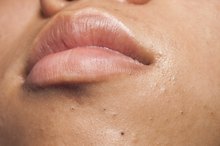What does fact checked mean?
At Healthfully, we strive to deliver objective content that is accurate and up-to-date. Our team periodically reviews articles in order to ensure content quality. The sources cited below consist of evidence from peer-reviewed journals, prominent medical organizations, academic associations, and government data.
- Indian Journal of Dermatology: Acne Vulgaris Treatment -- The Current Scenario
- Indian Journal of Dermatology: Acne Vulgaris Treatment -- The Current Scenario
The information contained on this site is for informational purposes only, and should not be used as a substitute for the advice of a professional health care provider. Please check with the appropriate physician regarding health questions and concerns. Although we strive to deliver accurate and up-to-date information, no guarantee to that effect is made.
Difference Between Blackheads & Sebaceous Filaments
Magazine images show perfectly poreless skin on models' noses and cheeks, but under the cosmetics and photographic manipulation, they probably have the same tiny indentations on the oiliest parts of their faces that others do. You might mistake these small dimples for the blackheads they resemble, but chances are most of them are not blemishes, but naturally occurring sebaceous filaments.
Sebum
Your skin contains thousands of minuscule glands that produce a waxy, oily material called sebum. If you have an oily complexion, your sebaceous glands are responsible. Overactive sebaceous glands arise from genetic predisposition to an oily skin and from hormonal activity. Under normal circumstances, your sebaceous glands keep your skin moisturized and supple, but when they become clogged, they can also become reservoirs for infectious bacteria.
- Your skin contains thousands of minuscule glands that produce a waxy, oily material called sebum.
- Under normal circumstances, your sebaceous glands keep your skin moisturized and supple, but when they become clogged, they can also become reservoirs for infectious bacteria.
Blackheads
Oil Bumps on the Face
Learn More
Sebum that builds up and solidifies into a plug within a pore forms a blackhead. Blackheads also consist of shed skin cells in addition to sebum. The naturally whitish sebum turns brown or black when it oxidizes, giving the blackhead its characteristic dark color. If your dermatologist presses the blackhead from your skin, you can see how the wormlike plug has a darker cap toward the end that was once exposed to the air. Don't try to express a blackhead from your skin yourself -- you risk scarring from squeezing.
- Sebum that builds up and solidifies into a plug within a pore forms a blackhead.
- The naturally whitish sebum turns brown or black when it oxidizes, giving the blackhead its characteristic dark color.
Sebaceous Filaments
If you look closely at the tip of your nose, you might see tiny dots that superficially resemble blackheads. While these marks are also the tips of columnar structures that fill your pores, these are not products of infection. They're sebaceous filaments, naturally occurring hairlike formations that channel the flow of sebum along the lining of the pore in which they lie. While this may not sound appealing, it's a natural phenomenon on almost everyone's skin.
- If you look closely at the tip of your nose, you might see tiny dots that superficially resemble blackheads.
- While these marks are also the tips of columnar structures that fill your pores, these are not products of infection.
Differences
Clogged Pores on Nose & Chin
Learn More
A blackhead is a solitary eruption on the skin, while sebaceous filaments form an even, random pattern throughout an oilier area of your skin such as your nose or chin. Blackheads tend to be larger and darker while sebaceous filaments have a grayish or tan hue rather than a blackhead's charcoal color. Sebaceous filaments typically feel smooth to the touch, unlike a large blackhead which might have a raised rim around the recessed, plugged pore. Blackheads may accompany whiteheads, the raised white pimples that indicate an acne breakout. Sebaceous filaments occur on virtually every adult's nose and bear no association with acne 2.
- A blackhead is a solitary eruption on the skin, while sebaceous filaments form an even, random pattern throughout an oilier area of your skin such as your nose or chin.
- Sebaceous filaments typically feel smooth to the touch, unlike a large blackhead which might have a raised rim around the recessed, plugged pore.
Related Articles
References
- Indian Journal of Dermatology: Acne Vulgaris Treatment -- The Current Scenario
- American Academy of Dermatology: Guidelines of Care for Acne Vulgaris Management
- Platsidaki E, Dessinioti C. Recent Advances in Understanding Propionibacterium acnes (Cutibacterium acnes) in Acne. F1000Res. 2018;7 doi:10.12688/f1000research.15659.1
Writer Bio
Lauren Whitney covers science, health, fitness, fashion, food and weight loss. She has been writing professionally since 2009 and teaches hatha yoga in a home studio. Whitney holds bachelor's degrees in English and biology from the University of New Orleans.









